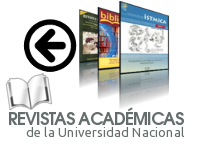Rostros y rastros del Nobel: Gabriel García Márquez veinticinco años después
Abstract
Gabriel García Márquez asume la oralidad del homo caribbeans como síntoma de diversidad , por oposición a la universalizante estandarización trascendental de la escritura, en palabras del antillano Edouard Glissant, y representa una reacción a la cultura letrada establecida por el sistema imperial occidental, custodiada por los organismos reguladores del orden establecido en el centro. De este modo, la literatura oficia como archivo cultural. A la luz de la concepción de literatura como escritura, es preferible hablar de diseminación, de intertextualidad, de palimpsesto, en vez de recurrir al trajinado concepto de influencias literarias. En tal sentido, Cien años de Soledad se constituye en un canon emergente, un código maestro, un nuevo mapa cultural que permite múltiples lecturas y re-escrituras. El realismo mágico pone en crisis el concepto aristotélico de mimesis del arte verbal y exige una nueva perspectiva de analisis.Según un importante sector de la critica, la obra garciamarquiana en sus diferentes rostros, desde las tempranas producciones del ciclo Macondiano hasta la Summa Amorosa que concluye con Del amor y otros demonios, señala el tránsito de la narrativa colombiana de la modernidad a la posmodernidad . Por cierto, veinte años después del Nobel, su rastro se puede seguir desde el campo novelístico nacional contemporáneo hasta recónditas geografias literarias del globo. El realismo mágico, así como en general la literatura del boom, constituye desde la década del setenta una nueva fórmula de respuesta a la situación posmoderna, dado que reemplaza el antiguo canon colonial hegemónico y sus ecos esencialistas, realistas y nacionalistas posteriores a la independencia, y proporciona una ficción de autorrepresentación de la realidad híbrida del discurso otro latinoamericano, en la que la categoría de lo maravilloso reemplazará a la de lo sublime. Sin duda, Macondo existe, es una región de la memoria. Pero sus límites no son occidentales. Dentro del mapa literario mundial, es vecino de remotos espacios geolingüísticos y geoculturales.Abstract
Gabriel García Márquez assumes the oral tradition of the homo caribbeans as a symptom of diversity, by an opposition to the universalizing standardization of writing, to use the words of Antillean writer Edouard Glissant, and represents a reaction against the educated culture established by the Western imperial system and kept by the regulating organisms of the established order in the center. Thus, literature represents a cultural file.Following the notion of literature as writing, it is preferable to talk about dissemination, intertextuality, or palimpsest instead of resorting to the overused concept of literary influences. In this sense, One Hundred Years of Solitude becomes an emerging cannon, a master code, a new cultural map that allows multiple readings and re-writings. Magic realism puts into crisis the Aristotelian concept of mimicry of the verbal art and demands a new perspective of analysis. According to an important sector of critique, the Garciamarquian work– in its different phases, from the early productions of the Macondian cycle to the Summa Amorosa that finishes with Love and Other Demons, represents the path of the colombian narrative from the modernism to postmodernism. By the way, twenty years after the Nobel, its path can be followed from the novel national contemporary field to distant literary geographies of the world. Magic realism, as well as in general terms the literature of the boom, makes from the sixties decade a new form of answering to the postmodern situation, because it substitutes the old colonial hegemonic cannon and its essential , realistic and national voices after the independence. It gives a fiction of sel-frepresentation of the hybrid reality of the other Latin American discourse, in which the marvelous category will replaced that of the sublime. With no doubt, Macondo exists, it is a region of the memory. But its borders are not Western, inside the literary world map, it is a neighbor of remote geolinguistics and geocultural spaces.
Downloads
How to Cite
Issue
Section
License
Las personas autoras que publiquen en esta revista permiten cesión gratuita, exclusiva, de ámbito mundial de sus derechos de autoría a la Universidad Nacional (Costa Rica), conservando únicamente sus derechos morales sobre la obra publicada.
Los artículos pueden ser citados y copiados, citando a la persona autora y la fuente. Todos los artículos publicados en la Revista Ístmica están protegidos bajo una Licencia Creative Commons Atribución-NoComercial-CompartirIgual 4.0 Internacional








